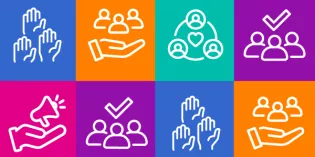This page is for those exploring, applying to or already in this sub-specialty training programme! We have insights from current specialists on what it's like working in paediatric intensive care medicine, opportunities to try out the sub-specialty and links to the relevant groups and other contacts.
Each sub-specialty has its own syllabus as part of Progress+ which you can download from this page, plus get details of the Intercollegiate Specialty Advisory Committee (ISAC) managing this sub-specialty.
- 1. What makes a paediatric intensivist?
- 2. A day in the life of a paediatric intensivist
- 3. How and where to experience paediatric intensive care medicine in your early medical career
- 4. Applying to a paediatric intensive care medicine programme
- 5. Information for paediatric intensive care medicine trainees
- External links
- Downloads
1. What makes a paediatric intensivist?
A paediatric intensivist is a clinician with a paediatric or anaesthetic / adult Intensive care medicine (ICM) background who resuscitates, stabilises, transfers and treats critically ill and injured children. They identify those children who need intensive care support and are skilled at the procedures and techniques necessary to deliver that support. They are highly skilled at directing, leading and coordinating both medical and surgical resuscitation, and can prioritise and respond to new and urgent clinical situations.
Paediatric intensivists treat children with a wide range of life-threatening pathologies within emergency, transfer and intensive care settings. They interact with, coordinate, educate and supervise all members of the multi-professional intensive care team, understanding the unique interaction of the intensive care unit with every component of the hospital. They work in difficult and challenging environments within the emergency, transfer and intensive care settings. They also coordinate and deliver appropriate care when a major incident has occurred.
2. A day in the life of a paediatric intensivist
By Dr Kim Sykes, Consultant Paediatric Intensivist in Southampton
"A paediatric intensivist may work in a mixed intensive care unit (ICU) or in a specialist ICU (e.g. Cardiac Intensive Care Unit) or work for a transport service. The day will vary depending on this.
"In ICU, my day usually starts with handover from the night team in the form of a morning conference which includes other members of the multi-disciplinary team (MDT) such as the cardiologists /cardiac surgeons. I then review each patient with the junior doctors and assist with procedures/imaging / investigations that the patient needs as well as updating the family. I often confer with a range of sub-specialists involved in the patient’s care to develop a comprehensive management plan to progress their care. I oversee the admission of patients following operations or via the emergency department/wards or following retrieval from a District General Hospital (DGH).
"Some of my shifts involve working for the transport service. In this capacity, I will provide decision support to DGHs on the phone as well as travel (ambulance/air) to the DGH to stabilise a patient and bring them back to PICU. In my Supporting Professional Activities (SPA) time, I have the opportunity to do a range of non-clinical activities such as teaching, service development, governance activities/audit and research."
3. How and where to experience paediatric intensive care medicine in your early medical career
As a medical student/foundation doctor you may need to specifically request a placement/work experience in PICU. We are always happy to have you! Some students choose to do elective periods with us during university holidays. You can also choose to do your medical student project with a PICU supervisor.
As a junior doctor in paediatrics/anaesthesia / ICM, you may have PICU included as one of your compulsory rotations or you can arrange to go out of programme (OOP) and undertake a PICU or transport fellowship.
The PICU environment is unique but you may come into contact with paediatric retrieval teams if you work in the emergency department. Alternatively, working on adult ICU / prehospital services will give you a flavour of the high acuity and busy life that we lead.
Attending a PICU conference/webinar can give you an idea of the range of pathology we treat as well as some of the other elements of care. They give you the opportunity to network with trainees and other members of the MDT. There are many Charities that support the delivery of ICU care in resource-limited environments. These missions can be a great opportunity to see intensivists at work.
4. Applying to a paediatric intensive care medicine programme
We are looking for doctors who have a clear understanding of what a job in PICU entails, including awareness of the high acuity / high stress that is a feature of a career in this field.
You need to demonstrate an aptitude for procedural-based care and evidence-based medicine as the PICU field continues to evolve apace. You need to demonstrate strong teamwork skills as well as an ability to manage conflict and thrive under pressure. You need to show potential to lead and develop a PICU service. Evidence of engagement in governance/research/teaching alongside clinical work is important.
Families accessing PICU are experiencing the worst time of their lives. You need to have the capacity to communicate effectively and empathetically with them as well as be committed to providing holistic care for them. You should be able to demonstrate an understanding of the importance of balancing the commitment to this type of work with personal interests and commitments to ensure your longevity in the sub-specialty.
- PICM specialty recognition within Intensive Care Medicine
-
Paediatric Intensive Care Medicine (PICM) is approved by the General Medical Council (GMC) as a specialty of Intensive Care Medicine. The Faculty of Intensive Care Medicine (FICM) sets the training requirements for adult Intensive Care Medicine (ICM). Trainees engaged in a Single or Dual CCT in ICM can undertake specialty accreditation in PICM via the RCPCH paediatric sub-specialty training programme.
Single ICM CCT trainees incorporate the PICM training into the existing programme, which requires no extension of training time. Trainees undertaking Dual CCTs in ICM and a partner specialty (e.g. Anaesthesia) may also wish to apply for the PICM specialty programme. Undertaking Dual CCTs and specialty recognition will, however, result in a significantly prolonged period of training with an additional 24 months required.
The full details of how PICM can be incorporated into the ICM training programme can be found within the FICM’s ICM curriculum.
5. Information for paediatric intensive care medicine trainees
Existing trainees should feel free to contact any member of the Intercollegiate Specialty Advisory Committee (ISAC) for career advice/support. We also provide online masterclasses dealing with post-Certificate of Completion of Training (CCT) fellowship opportunities as well as preparing for the consultant Interview/life as a consultant.
External links
To find out more about paediatric intensive care medicine, the ISAC recommend the following websites as useful resources:










